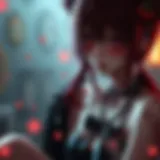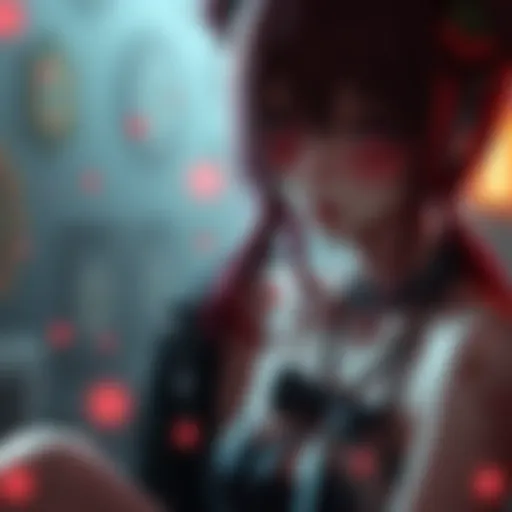Exploring Genjutsu: The Illusionary Art in Anime
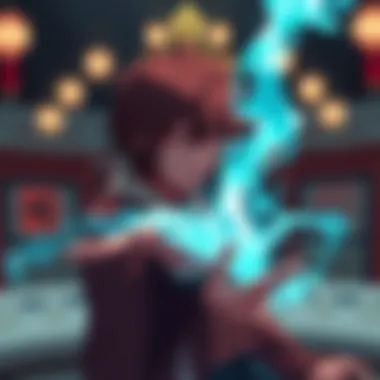

Intro
Anime frequently dazzles audiences with spectacles that straddle the line between reality and fantasy, and at the core of many hauntingly beautiful narratives lies the notion of genjutsu—an art form that manipulates perception and invokes compelling illusions. This technique, prevalent in popular series such as Naruto and Demon Slayer, holds a unique charm as well as the potential for grand mischief. Illusions can shape not only the plot but also the audience’s emotional landscape.
Transforming the way characters interact with each other and their environments, genjutsu serves as a powerful plot device. It raises questions about what is real—forcing viewers to grapple with their own perceptions. Examining its intricate workings reveals how genjutsu enriches anime storytelling and character development.
In this exploration, we shall dissect the layers of genjutsu—its origins, techniques, and themes—and analyze some noteworthy examples. Through these lenses, the rich tapestry of anime unfolds, exposing not only entertainment value but the deeper cultural reflections rooted within.
Features of Popular Anime Apks
When delving into the world of anime, many enthusiasts turn to specific applications to enhance their viewing experience. These platforms vary in functionality and user experience, but they share some key features that stand out:
- User-Friendly Interface
Anime apps often boast streamlined designs. This makes navigating between shows a breeze, allowing users to find their favorites without feeling overwhelmed by clutter. - Compatibility with Multiple Devices
A significant advantage of anime apps is their availability across various devices—phones, tablets, and smart TVs. This adaptability assures that whether you're commuting or lounging at home, indulging in your anime fix is just a tap away.
How to Download and Install Anime Apks
For those wishing to dive into the depths of anime, understanding how to install these applications is vital. Here is a straightforward step-by-step guide that suits both tech novices and experts alike:
- Choose a Reputable Source:
It is crucial to download anime APKs from known websites or apps to avoid security threats. Websites like reddit.com/r/anime often provide updates on the best APK sources. - Enable Unknown Sources:
Go to your device settings, navigate to security, and allow installations from unknown sources. This step ensures that the app can be installed without standard restrictions. - Download the APK File:
Click on the download link provided by your chosen source. Wait for the process to complete before proceeding. - Install the App:
Once the APK file is downloaded, locate it in your downloads folder, click on it, and choose ‘Install.’ - Launch and Enjoy:
After installation, open the app, and you're ready to explore a universe full of captivating tales and mesmerizing visuals.
Troubleshooting Common Issues
It’s not uncommon to run into a snag during the installation or usage of anime APKs. Addressing these common glitches can streamline your experience:
- Incompatibility Errors:
If the app isn't working, check whether your device meets the necessary requirements. Sometimes, older devices struggle with newer applications. - Missing Features:
If certain functionalities seem absent, ensure that the app was fully updated. Outdated versions can miss pivotal features. - Playback Issues:
Video not loading or buffering? Steady internet connections are key here—try switching from mobile data to Wi-Fi or vice versa.
By mastering these features and troubleshooting methods, you'll find yourself fully immersed in anime's otherworldly charms. For more insights and capable troubleshooting, communities on platforms such as facebook.com/groups/anime can be an invaluable resource.
Prologue to Genjutsu
Genjutsu, a fascinating concept deeply embedded in the anime landscape, plays a significant role in shaping narratives and character arcs. At its core, genjutsu refers to illusionary techniques that manipulate the senses of the victim, crafting a reality that is both captivating and unsettling. Understanding genjutsu not only unveils a layer of storytelling mastery but also illuminates the psychological underpinnings that anime creators utilize to engage viewers on multiple levels.
Within this discussion, we explore how genjutsu acts as a powerful tool for character development and conflict. The beauty of this technique lies in its ability to reflect the internal struggles of characters, showcasing their fears, aspirations, and vulnerabilities. As audiences, we are invited to explore these multidimensional aspects through the enchanting veil of illusions. This nuanced engagement invites a deeper emotional connection with the story, encouraging viewers to reflect on their own perceptions of reality.
Additionally, the exploration of genjutsu extends beyond mere entertainment; it serves as a lens through which we can analyze broader cultural themes. The interplay of illusion and reality raises questions about truth, perception, and the nature of existence — themes that resonate with many aspects of modern life. Such complexities enrich the anime narrative, highlighting its relevance in contemporary discourse.
In this article, we will delve into the intricate layers of genjutsu, from its foundational definitions to its historical roots. By analyzing key anime examples, we will uncover how these elements weave together to enhance storytelling and character depth. Let’s embark on this journey to grasp the true essence of genjutsu and its significant impact on the world of anime.
Definition of Genjutsu
Genjutsu can be defined simply as a form of illusionary magic that misleads the victim's senses. Unlike physical combat skills in anime, genjutsu operates on a mental plane, where perception becomes the battlefield. In essence, a skilled user can cast an illusion so convincing that the target experiences it as reality, effectively navigating the boundaries between what is real and what is fabricated. This manipulation can cause varied outcomes ranging from fear and confusion to tranquility and euphoria.
The most notable aspect of genjutsu is its psychological nature. It not only affects the targeted character but serves as a substantial narrative device. For example, a character caught in a genjutsu may confront inner demons or unresolved conflicts, providing an avenue for growth or revelation. The use of genjutsu leads to an unfolding of deeper themes in storytelling, laying the groundwork for character transformation, and inviting viewers to ponder their perceptions of the world around them.
Historical Context
To truly appreciate genjutsu in anime, it’s essential to explore its historical roots, particularly in Japanese folklore and traditions. The concept of illusion and trickery can be traced back to ancient narratives, where supernatural beings and magical occurrences often depicted the fluidity of perception. Tales of yokai, or spirits, frequently included elements where characters would fall victim to illusions, impacting their actions and fates.
Old tales indicate that understanding koto no hanashi, or the art of storytelling, included not just recounting events but also engaging the audience's imagination through vivid imagery and clever ruses. Genjutsu emerged as a modern interpretation of these age-old motifs, blending them with contemporary storytelling techniques in anime.
Anime series have since evolved to build upon these rich narratives, introducing audiences to complex characters and multifaceted plots that draw on this historical context. The intertwining of illusion with the human experience reflects not just a form of entertainment, but also an exploration of cultural identity, ethics, and the very nature of reality itself. This historical lens accentuates the continual evolution of genjutsu, enriching the viewer's journey through the colorful world of anime.
The Mechanics of Genjutsu
The intricacies behind genjutsu are what elevate this element from mere spectacle to a profound tool for storytelling in anime. Understanding the mechanics of genjutsu is essential for both viewers and creators as it dives into the fabric of perception, reality, and the psychological battles that unfold within characters' minds. By comprehensively examining this aspect, one can appreciate how genjutsu serves not only as a source of conflict but also as a means to explore deeper themes of identity and psyche.
Techniques of Illusion Crafting
Illusions created through genjutsu often rely on various techniques that manipulate the user's sensory experience. These techniques can range from basic auditory hallucinations to complex, richly detailed scenarios that seem palpably real. Here are few prominent methods observed in various anime:
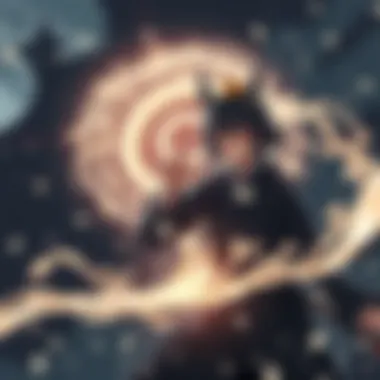

- Visual Manipulation: This is a hallmark of genjutsu, where characters perceive an alternate visual environment. For example, in Naruto, characters experience landscapes that shift dramatically, forcing them to confront illusions that challenge their understanding of the world.
- Auditory Deceptions: Sounds can play tricks on a person's mind. Some characters hear voices or phantom sounds that heighten emotional states, creating a sense of drift from reality.
- Sensory Overload: In certain narratives, genjutsu can flood the senses with overwhelming stimuli, making it difficult for characters to differentiate between what is real and what is imagined.
- Memory Manipulation: Characters sometimes face illusions that alter their memories or recreate traumatic experiences, forcing confrontations with their past.
These techniques reveal the depths of a character's emotional and mental states, framing their struggles within the broader narrative context. When viewers encounter these crafted illusions, they navigate through complex layers of truth and deception alongside the characters, engaged in psychological introspection.
Psychological Impact on Characters
The ramifications of genjutsu extend beyond visual trickery, deeply embedding themselves in the psychology of characters. When characters are ensnared in illusions, they often experience profound internal conflict. Here are some examples of how this plays out:
- Identity Crisis: The use of genjutsu can force characters to reassess who they are. A perfect case of this is seen in Naruto, where characters confront versions of themselves they fear or hate, leading to moments of revelation.
- Fear and Anxiety: Characters may endure their worst fears amplified by genjutsu. This not only raises the stakes in confrontations but can also lead to significant character development as they navigate through these emotions.
- Moral Dilemmas: Characters may face scenarios that challenge their ethical beliefs, questioning their motivations or alliances due to illusions that convolute their perception of right and wrong.
In sum, genjutsu's psychological impact prompts not just immediate reactions but lasting changes in the characters' arcs. It showcases how perception can be altered and manipulated, revealing nuances in human experience and the fragility of reality. By examining these effects, both creators and viewers gain insight into the profound narratives that can be spun through the art of illusion.
Cultural Significance of Genjutsu
The cultural significance of genjutsu is deeply embedded in both traditional and modern narratives, illustrating its evolution from age-old tales to contemporary anime. It offers a lens through which to examine the interplay of illusion, reality, and human psychology. This significance extends beyond mere entertainment, as it invites viewers to reflect on their own perceptions and the nature of reality.
Genjutsu in Japanese Folklore
In Japanese folklore, illusions and supernatural occurrences have long held a place in storytelling. Genjutsu draws its roots from these ancient beliefs, reminiscent of the yokai, or spirit creatures, that can distort reality. Folktales often depict these supernatural beings using illusions to deceive humans, leading them astray or teaching them moral lessons. For instance, the kitsune, a fox spirit, can create illusions that entrap unsuspecting travelers, showcasing the duality of deception—both a means of protection and a source of danger.
This historical context highlights how genjutsu is not just a narrative device; it serves as a cultural artifact that echoes the fears and curiosities of Japanese society. The integration of genjutsu in anime continues this legacy, allowing creators to explore complex themes such as identity, agency, and the unforeseen consequences of deception. As anime evolves, these traditional narratives are transformed, providing a fresh take on age-old tales.
Connection to Modern Psychological Themes
Genjutsu parallels many modern psychological themes, particularly concerning perception and self-awareness. In a world saturated with information, the distinction between reality and illusion can become blurred. Anime effectively harnesses this blurred line, offering viewers narratives that resonate with contemporary anxieties.
Psychologists often discuss how individuals construct their realities based on perceptions. In moments of crisis or stress, one might create personal illusions as a coping mechanism. Here, genjutsu becomes more than a technique; it transforms into a metaphor for the human experience. Characters ensnared within these illusions often face profound challenges that mirror real-world dilemmas such as anxiety, depression, or the quest for authenticity in the age of social media.
Moreover, genjutsu’s framework encourages reflections on trust and betrayal, prompting audiences to evaluate their relationships. When a character falls victim to an illusion, it begs the question: who can we trust? This complex interplay of emotional themes not only enhances character depth but also enriches the viewer's engagement with the narrative.
In summary, the cultural significance of genjutsu is ingrained in its historical roots in Japanese folklore and its relevance to modern psychological themes. It encourages audiences to question the nature of reality while reflecting on their experiences and cultural narratives.
Key Examples in Anime
In the realm of anime, the concept of genjutsu serves as a fascinating narrative device that deepens storyline complexity and character development. Instances of genjutsu not only spotlight individual struggles and internal conflicts but also act as vehicles for broader thematic exploration. By examining these key examples, fans can appreciate how such illusions echo real-life psychological challenges and philosophical questions. This section delves into notable works while uncovering the intricacies hidden within their engaging narratives.
Notable Anime Featuring Genjutsu
Several anime series artfully weave genjutsu into their narratives, offering viewers a rich tapestry of psychological drama entwined with fantasy elements. A few standout titles include:
- Naruto: The concept of genjutsu is tightly woven into the fabric of the Naruto universe. Techniques like the Sharingan pave the way for mind-bending battles and self-realization.
- Death Note: While not traditionally categorized under genjutsu, the mind games and psychological manipulation present in Death Note can be seen as a contemporary parallel.
- Steins;Gate: This series, with its time-travel narrative, crafts hallucinations and manipulated realities that resonate with the essence of genjutsu, challenging the perception of time and truth.
By viewing these examples, it becomes apparent that genjutsu is not merely about illusions. It extends into the realm of psychological narratives, revealing the emotional backstories of characters and fostering connection for viewers.
Analysis of Specific Episodes
Episode Reviews
Focusing on specific episodes allows for a closer examination of how genjutsu operates within these narratives. For instance, in Naruto, the Itachi Uchiha vs. Sasuke Uchiha battle stands out because it showcases the distillation of trauma into a vivid illusion. The portrayal of Sasuke's internal conflicts through genjutsu provides an exceptional example of character depth and emotional engagement. This approach is not just entertaining; it reflects the characters' mental states and growth.
One unique feature about this episode is its visual representation of genjutsu. As viewers witness the contrast between reality and illusion, it becomes a powerful tool for storytelling. The way genjutsu engages with emotional truths sets this episode apart, making it a vital inclusion in any discussion on the topic.
Character Responses to Illusions
Exploring how characters respond to illusions sheds light on their moral and ethical quandaries. In Naruto, characters like Naruto or Sakura often have profound reactions to genjutsu, portraying fear, strength, or confusion. This helps viewers understand their motivations and vulnerabilities better.
The key characteristic of these responses lies in character development. For instance, Sasuke's journey into the depths of his emotions and regrets during a genjutsu sequence illustrates his transformation throughout the series. This emphasizes how the character arc is intricately linked with the illusions they experience, showcasing genjutsu’s critical role in storytelling.
Unfortunately, not all portrayals of genjutsu are flawless. Some viewers may find the frequent use of illusion could lead to narrative fatigue or confusion, making it important for writers to strike a balance. Nevertheless, the benefits of using character responses to enrich plotlines cannot be understated. They keep the narrative grounded in emotional realities while engaging the audience in meaningful exploration of fear and morality.
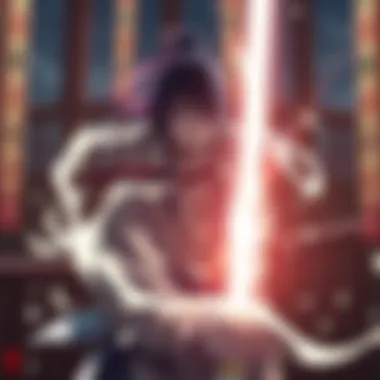

In summary, the exploration of key examples illustrates that genjutsu is much more than a simple narrative trick; it is an essential component that enriches storytelling, character arcs, and thematic depth in anime. For more information on anime and genjutsu, resources such as Wikipedia can offer further insights into this captivating topic.
Character Development Through Genjutsu
In the world of anime, character development can often be a pivotal aspect that drives a show's narrative, impacting plot lines and viewer engagement. Genjutsu serves as a powerful tool in this developmental process, allowing characters to confront their fears, desires, and inner conflicts through illusions. As these characters navigate through the intricacies of genjutsu, viewers witness their transformations which can lead to profound revelations about their true selves.
The art of illusion weaves a complex tapestry that influences not only the individual character but also how they relate to others within their universe. By exploring characters’ psyche through genjutsu, stories highlight critical turning points in their arcs. This not only emphasizes personal growth but also showcases the vulnerabilities that render each character relatable, fostering a deeper emotional connection with the audience.
Transformation of Key Characters
When examining specific characters who undergo transformations due to genjutsu, one cannot overlook the esteemed Sasuke Uchiha from Naruto. Throughout the series, Sasuke encounters various scenarios that manipulate his perception. Initially, he falls prey to Itachi's manipulative techniques. This is no mere skirmish; rather, it exposes his inadequacies and grudges tied to familial loss. The genjutsu experienced here is not just an illusion but a deep psychological manipulation that forces him to grapple with his motivations and feelings of revenge.
Thus, through genjutsu, viewers can see how a character morphs from a vengeful youth to a more contemplative adult. The subtle layers intertwined in his journey are unpeeled as illusions challenge his ambitions and thoughts. In essence, genjutsu does not merely function as a plot device but becomes an integral medium facilitating character evolution.
Another gripping example is from Bleach, particularly with Ichigo Kurosaki. Genjutsu plays a crucial role in his battles against characters like Aizen, who utilizes illusions to play on Ichigo’s fears associated with inadequacy and loss. The sight of friends falling victim to illusions shapes Ichigo's emotional state and fuels his determination to rise above, emphasizing the crucial moments where character resilience comes into play even amidst confusion.
Moral Ambiguities and Ethical Dilemmas
The deployment of genjutsu raises numerous ethical questions that resonate through the narratives of various anime series. Characters confronting their own moral compass during these illusions create an intricate dance of choices and consequences.
In stories where genjutsu is wielded as a tactical advantage, it prompts discussions about the ethical implications behind manipulating one's perception. Characters like Madara Uchiha in Naruto manipulate others into experiencing idealistic dreams. While he seeks peace, the cost of this peace questions the validity of his method. Is it justified to impose a false reality for the sake of a greater good? This universe dangles moral dilemmas right before the viewer's eyes, prompting them to dissect each action and intention.
"Illusions can often provide a pathway to truth, however twisted."
Moreover, these experiences can lead to characters of ethical uncertainty. For instance, in Death Note, the genjutsu-like manipulation of information by Light Yagami casts shadows on righteousness. He is led to believe that he is in the right, but is he merely baking his own destruction? This conundrum showcases how genjutsu can reflect internal struggles too, as personal beliefs and values are tested under the weight of manipulation.
Viewer Interpretation of Genjutsu
Understanding the concept of genjutsu extends beyond the confines of mere entertainment; it serves as a catalyst for dialogue among observers, especially in anime fandom. The viewer's interpretation of genjutsu can unravel deeper philosophical implications and social commentaries inherent in the narratives. It encourages critical thinking about the very nature of reality presented in these stories and how perception can easily be manipulated. Each fan derives personal significance from the experiences depicted, often reflecting their own confrontations with the elusive boundaries of truth and illusion.
By engaging with genjutsu, audiences not only react emotionally but also intellectually. This dual reaction adds layers to the viewing experience. The hallmarks of effective genjutsu scenarios often rely heavily on the nuanced responses elicited from watchers. Here are some benefits of analyzing audience interpretations:
- Increased engagement: The complex nature of genjutsu invites viewers to speculate and theorize, thus fostering deeper involvement with the material.
- Cultivating empathy: Often, the characters ensnared in these illusions endure psychological conflicts, allowing viewers to reflect on their struggles and react with a sense of empathy.
- Awareness of manipulation: The themes of control and choice, pivotal in genjutsu, tend to resonate, prompting discussions about manipulation in real-life scenarios.
These points subtly fuel detailed discussion among fans in various settings, from informal gatherings to dedicated forums. As one delves into the essence of genjutsu, it becomes apparent that the line between illusion and reality has profound implications— not just for the characters, but for viewers themselves.
Audience Reactions to Genjutsu
The reactions from the audience towards genjutsu can vary dramatically, showcasing the intricacies of human perception and emotional responses. Some viewers may revel in the moments of disbelief, relishing the art of illusion as it unfolds, while others might feel uneasy, unsure of the consequences that stem from the experienced manipulations.
The emotional spectrum runs the gamut from joy and awe to confusion and discomfort. Below are some common audience reactions:
- Awe: Many viewers are captivated by the sheer creativity involved in the genjutsu displays, appreciating the artistry behind each illusion.
- Shock: Certain twists involving genjutsu provoke visceral reactions, forcing audiences to reevaluate their understanding of a character's motives or mental state.
- Frustration: Expecting clarity, some fans struggle when confronted with ambiguities that arise from elaborate genjutsu schemes. This can lead to frustration and debate among discussions.
Viewers often take to platforms such as Reddit and fan forums to voice their thoughts, share theories, and dissect specific scenes. Those discussions cultivate a sense of community, as people unite under their shared confusion or admiration for various genjutsu forms. These interpretations not only enhance personal enjoyment but also enrich the collective understanding within the fan base.
Fan Theories and Discussions
Fan theories surrounding genjutsu highlight the depth of engagement audiences are willing to undertake. Often, viewers formulate elaborate theories explaining the underlying reasons for certain illusions or questioning the lucid line between a character's perception and reality. This accretion of differing theories builds a rich tapestry of discourse, revealing how complex the interpretation of genjutsu can be. Here’s what typically fuels these discussions:
- Speculation on character motivations: Observers might consider how the experience of genjutsu shapes a character's growth or leads to pivotal decisions along their journey.
- Connections to larger themes: Some fans draw parallels between the illusions encountered and broader societal issues, such as misinformation or identity crises, effectively positioning the anime in a real-world context.
- Debate over effectiveness: Various panels and discussions also arise regarding the success of certain genjutsu depictions. Some fans may argue whether the effects are genuine illustrations of psychological turmoil or simply narrative conveniences.
The constant churn of theories thrives off each episode's cliffhangers or shocking reveals, ensuring that dialogue continues long after the episode has aired. Locations such as Facebook groups and specialized subreddits host many of these discussions, as fans collaborate in untangling the webs formed by genjutsu.
Comparative Analysis: Genjutsu vs Other Forms of Manipulation
The art of deception has always captivated audiences. In the realm of anime, genjutsu emerges as a unique form of manipulation, designed to distort reality and ensnare characters within illusory landscapes. Understanding genjutsu in a broader context, particularly in comparison to other methodologies of manipulation, reveals not just its distinct qualities but also its deeper significance in storytelling. Through this dissection, we'll illuminate some key contrasts not just with ninjutsu, the technique of physical combat, but also touch on its threads entwined with psychological thrillers.
Genjutsu in Contrast with Ninjutsu
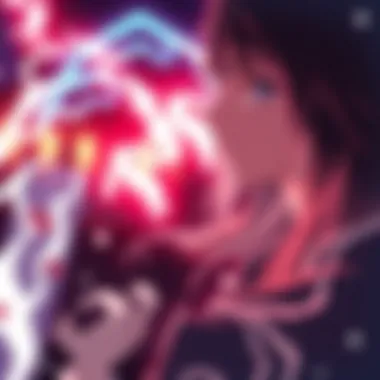

While genjutsu and ninjutsu can often be found dancing the same waltz on the thematic floor of many anime, their essence couldn't be more different.
- Ninjutsu embodies the physical. This practice involves real techniques, like stealth movements and martial arts that deliver a tangible result. Characters use ninjutsu to perform feats of strength, speed, and cunning, often engaging in fierce battles.
- On the other hand, genjutsu captures the mind. It's about the illusions wrapped around consciousness, altering what a character perceives. The manipulation occurs within the psyche, distinct from the brutal physicalities of ninjutsu.
Here’s how they stack up:
| Aspect | Genjutsu | Ninjutsu | | Focus | Mind and perception | Physical prowess | | Technique Type | Illusion crafting | Combat and techniques | | Common Use | Psychological manipulation | Tactical warfare | | Impact | Emotionally driven | Physically devastating |
Genjutsu can often be more dangerous. You might throw a strong punch in Naruto, but the scars from a well-executed illusion can run deeper, leaving lasting effects not just on the individual but on the narrative itself. Consider Itachi Uchiha and his mastery of genjutsu; he doesn’t just incapacitate foes; he digs into their very souls, confronting them with their biggest fears and insecurities, effectively redefining the fight before it even starts.
Similarities with Psychological Thrillers
When you peel back the layers, genjutsu remarkably aligns with the premises found in psychological thrillers. Take, for instance, the puzzling nature of perception versus reality found in both genres. In genjutsu, characters grapple with illusions, questioning what is real. Similarly, in psychological thrillers, the narrative often centers around distorted truths, misleading appearances, and acute emotional turmoil.
A few notable parallels include:
- Ambiguity of Truth: Just as a protagonist in a thriller must navigate through layers of deception, a character ensnared in genjutsu cannot trust their own senses. This creates suspense, keeping audiences on the edge of their seats.
- Character Vulnerability: In both scenarios, the vulnerability of the character is spotlighted. The mental landscape becomes the battleground. For instance, when Naruto faces off against Obito Uchiha, both characters encounter realities molded by their opponent’s will, showcasing how susceptible individuals are to manipulation.
- Emotional Manipulation: Genjutsu intricately weaves emotional threads into its fabric, much like a crafty psychological thriller. It can exploit a character's fears, grief, or guilt, crafting an experience that’s far more complex than mere physical confrontation.
"In the dance of reality and illusion, it is often the shadows that hold the truths we fear to confront."
This shared thematic exploration between genjutsu and psychological thrillers enriches the narrative layers in anime, allowing viewers to ponder the consequences of manipulation, reality, and the fragile nature of the human mind.
The comparative analysis between genjutsu and other forms of manipulation not only highlights the technical differences but fosters a deeper appreciation for the intricate storytelling found in anime. By understanding these dynamics, fans can better appreciate the multifaceted ways in which their favorite series engage with the theme of reality versus illusion, immersing them in a narrative world that challenges their perceptions.
Future Trends in Genjutsu Representation
As the world of anime continues to evolve, so does the depiction of genjutsu. Over the years, we've witnessed a significant shift in how illusions are crafted and portrayed. This topic is not just a footnote in the genre; it represents a crucial facet of storytelling that reflects changing audience sensibilities and technological advancements. Understanding these trends can shed light on the future of narrative structures and thematic depth in anime.
Emerging Themes in New Anime
Recent anime series are integrating genjutsu with fresh themes that resonate with contemporary issues. From identity crises to mental health awareness, creators are using illusion to represent internal struggles. For instance, Re:Zero - Starting Life in Another World incorporates genjutsu-like scenarios where the lead character faces multiple deaths, forcing him to confront his own psyche. This kind of narrative highlights the psychological warfare that these illusions can impose on individuals.
Newer titles are also putting a spotlight on the idea of perception vs. reality, challenging viewers to dissect what they see. The notion that one’s reality can be manipulated reflects growing societal concerns regarding media manipulation and misinformation. Just like audiences are bombarded with conflicting narratives in daily life, characters in these anime grapple with discerning truth from elaborate lies. This connection to real-world issues enables a stronger engagement with audiences who may find parallels with their experiences.
- Key emerging themes include:
- Identity and self-perception
- Mental health and psychological struggles
- Reality vs. illusion in media representation
"Illusion is a bridge between reality and imagination; where one navigates depending on their perception."
The Role of Technology in Evolving Genjutsu
Technology plays a pivotal role in shaping how genjutsu is represented in anime. The advent of CGI and advanced animation techniques have allowed creators to explore more sophisticated forms of illusion. This evolution results in striking visuals that can captivate audiences in ways traditional hand-drawn animation might not achieve. The simulation of complex illusions, such as environments that shift beneath a character’s feet or surreal landscapes, becomes more engaging and believably immersive.
Moreover, the accessibility of information through the internet enables both creators and fans to challenge the norms surrounding genjutsu. Online platforms like Reddit and discussion forums allow for shared analysis and user-generated content. Fan theories and discussions often influence how anime creators perceive and tweak their narratives. With platforms like Reddit, audience engagement becomes collaborative, further enhancing the thematic representation of genjutsu.
As production tools become more sophisticated and affordable, we can expect a growing use of interactive elements in narratives, where audiences might find themselves choosing paths that align more with their perceptions of reality—shifting the experience from mere observation to active participation.
Both the augmentation of technological capabilities and the growing desire to address deeper issues suggest an exciting horizon for the representation of genjutsu in anime. With fans capable of voicing their interpretations and influencing future works, there's a cyclical relationship developing between creators and their audience, making the art of illusion more dynamic than ever.
End
In wrapping up this exploration of genjutsu, it's crucial to recognize the profound importance of this concept in anime. Genjutsu serves not only as a narrative device but also as a mirror reflecting societal fears, desires, and philosophical inquiries. Its ability to manipulate perceptions highlights significant aspects of human psychology, leading us to question reality itself.
Summary of Findings
This article has traversed a myriad of dimensions regarding genjutsu:
- Techniques of Illusion: We've seen how skilled animators craft complex illusions, creating visual spectacles that captivate and challenge viewers. These illusions often parallel the characters' emotions, intensifying their journeys.
- Cultural Significance: Significantly, genjutsu finds roots in Japanese folklore, showcasing a long-standing tradition of utilizing illusions to depict moral stories. This connection enriches the viewer's experience by providing deeper cultural context.
- Impact on Character Development: Through various anime examples, it's evident that genjutsu allows characters to face their innermost fears and dreams, driving their growth and transformations.
- Viewer Engagement: Audiences engage actively with the themes of illusion, sparking discussions and theories, demonstrating a shared investment in the narrative's depth.
Final Thoughts on Genjutsu
Ultimately, genjutsu transcends mere trickery or visual delight in anime; it encapsulates the struggle between illusion and reality. As viewers, we find ourselves not just passive recipients of stories but active participants grappling with the weight of perception. Such complex narrative layers give anime its remarkable power to resonate with audiences on multiple levels, pushing us to contemplate our own perceptions of reality.
As the anime landscape continues to evolve with technology influencing storytelling, it's likely that genjutsu will transform yet again, perhaps leading to even more intricate interactions with viewers. Whether one is a die-hard anime fan or a casual viewer, genjutsu invites reflection on the nature of truth and illusion, making it a standout topic within the anime discourse.










